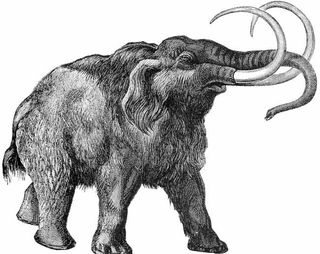Woolly Mammoths Existed in Two Distinct Groups

Two genetically distinct groups of woolly mammoths once roamed northern Siberia, a new study suggests, with one group dying out long before humans showed up. The finding suggests humans were not the only reason for the beasts' demise, as some have suggested. Scientists had long thought that woolly mammoths were one large homogeneous group, but an international group of scientists studied the mitochondrial DNA — the DNA in the genes of the mitochondria structures within cells — to paint a new picture of the ancient pachyderms. They extracted the DNA from frozen hair samples obtained from individual woolly mammoth specimens, found throughout a wide swath of northern Siberia. They compared 18 complete genomes of mitochondrial DNA and found evidence of two genetically distinct clades, or groups of the elephant-like beasts. "The population was split into two groups, then one of the groups died out 45,000 years ago, long before the first humans began to appear in the region," said study team leader Stephan C. Schuster of Penn State University. Schuster and his team also found that each group had a low genetic diversity — in other words, individuals within each of the woolly-mammoth groups were very closely related to one another. "This low genetic divergence is surprising because the woolly mammoth had an extraordinarily wide range: from Western Europe, to the Bering Strait in Siberia, to North America," said study team member Webb Miller, also of Penn State. He added that this low genetic diversity "may have degraded the biological fitness of these animals in a time of changing environments and other challenges." The research, funded by Penn State, Roche Applied Science and a private sponsor, indicates that the diversity of the two woolly-mammoth groups was as low centuries ago as it is now in Asian elephants living in southern India, which has been suggested as contributing to the problem of maintaining thriving groups of Asian elephants, Schuster said. In their paper, which appears in the June 9 issue of the journal Proceedings of the National Academy of Sciences, the researchers note that the smaller clade appears to have died out before the larger clade, possibly as a result of genetic drift, or the frequencies with which certain forms of a gene are passed to later generations, purely as a matter of chance. Because the population had such a small range, the lack of diversity could have left them vulnerable to a sudden change in their environment. "This discovery is particularly interesting because it rules out human hunting as a contributing factor, leaving climate change and disease as the most probably causes of extinction," Schuster said.
- The Top 10 Worst Heredity Conditions
- Scientists Aim to Revive the Woolly Mammoth
- Images: The World's Biggest Beasts
Sign up for the Live Science daily newsletter now
Get the world’s most fascinating discoveries delivered straight to your inbox.

Andrea Thompson is an associate editor at Scientific American, where she covers sustainability, energy and the environment. Prior to that, she was a senior writer covering climate science at Climate Central and a reporter and editor at Live Science, where she primarily covered Earth science and the environment. She holds a graduate degree in science health and environmental reporting from New York University, as well as a bachelor of science and and masters of science in atmospheric chemistry from the Georgia Institute of Technology.
